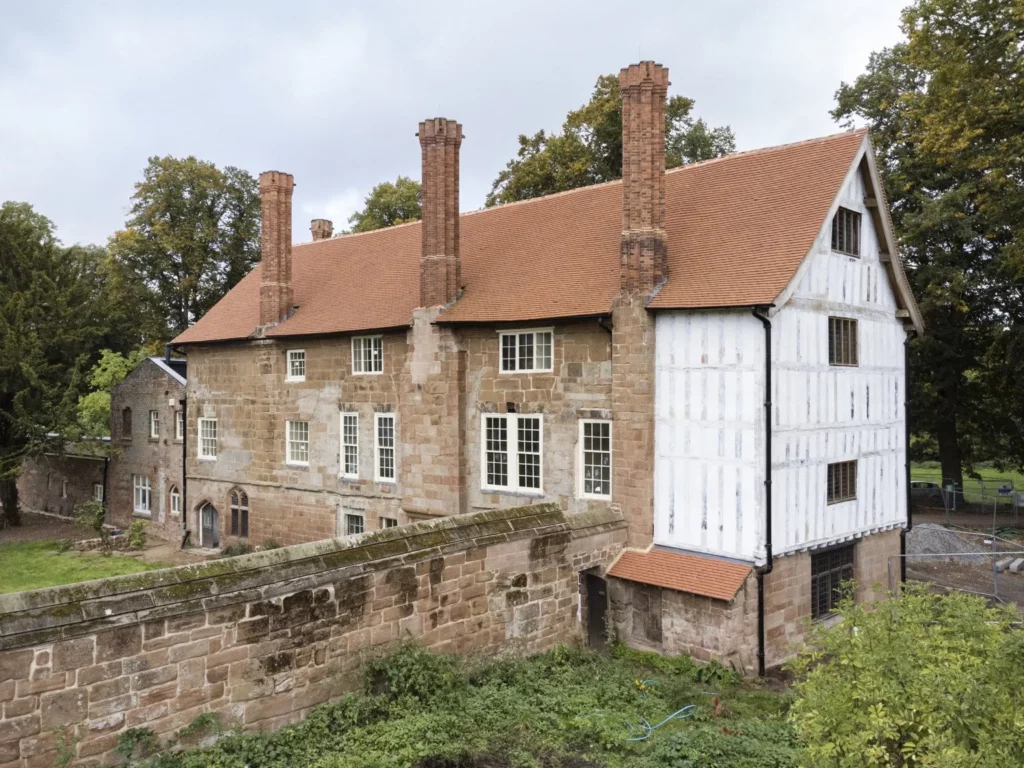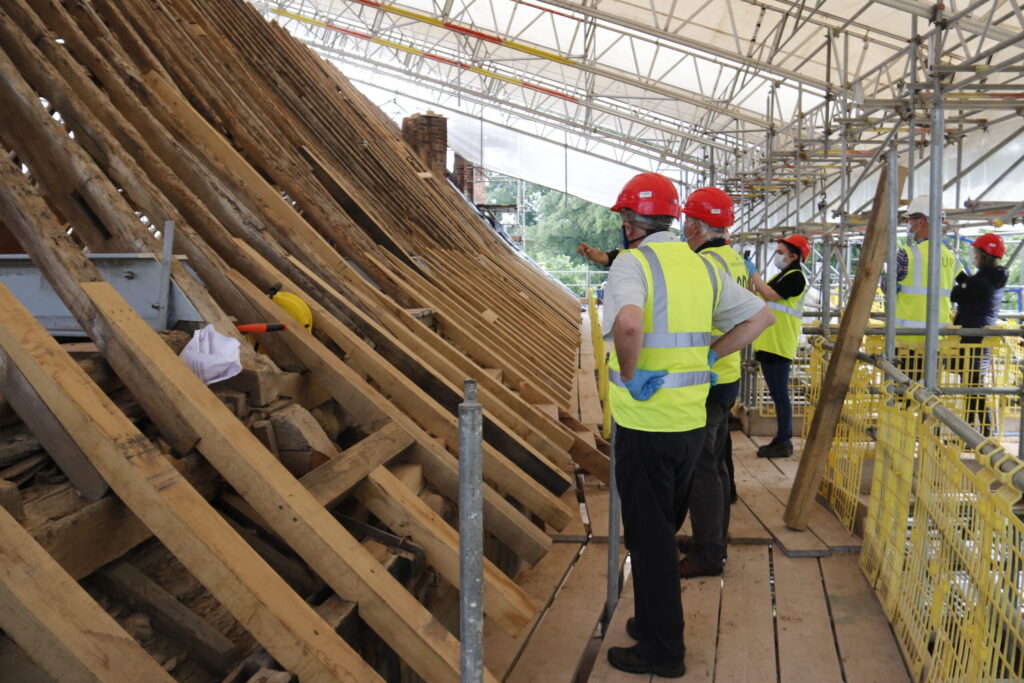
With the re-opening of the Grade 1 Listed Charterhouse tomorrow, we look back on the history of the building and the mammoth task of bringing it back to life.
The History of Charterhouse
According to the Historic Coventry Trust website, the history of the Charterhouse goes back to 1381 when Lord William Zouche of Harringworth, a patron of Coventry’s Carthusian monks, bought fourteen acres of land in Coventry from local lord Sir Baldwin Frevill, for the purposes of building a settlement for his newly arrived order.
The land by the River Sherbourne was chosen as the perfect place for the new ‘Charterhouse’, the English name for a Carthusian monastery from a rough translation of the original French word ‘chartreuse’.
Coventry’s Charterhouse gained its first royal patron after Lord Zouche died. A young King Richard II, along with his queen Anne of Bohemia, declared themselves founders and on 6 September 1385, the king came in person to lay the foundation stone of the Carthusians’ new church.
‘In the year of our Lord 1385…Richard, King of England, the principal founder of the house of St. Anne…laid the first stone in the foundation of the church with his own hands.’ – Translated from a Latin history written in the 1400s, edited by 17th century antiquarian Sir William Dugdale.
The site included a church, a chapter house, the Great Cloister surrounded by 12 individual monks’ cells, and the Prior’s Cell and refectory, now the main building known as the Prior’s House. Near the Prior’s House there was probably also a guest house, bakery, brewery, kiln house and granaries.
Each monk lived in a self-contained cell, a two-storey dwelling within a small walled garden. Remains of these cells, and of the church, have been discovered through archaeological excavation on site.
As a mostly silent order, the Carthusians embody the virtues of solitude and contemplation, and the monks would have spent the majority of their time alone in their cells without speaking. They spent their time worshiping, studying scripture and praying, attending mass at the church three times a day. The monastery was self-sufficient, and the monks grew their own fruit, vegetables and herbs and fished in the river. The outer precinct walls contained not only the religious buildings and living quarters, but also an orchard, a mill, and fishponds.
The peaceful life of Coventry’s Carthusians came to an end in the 16th century with the dissolution of the monasteries, when Henry VIII disbanded religious communities, took over their income and seized their assets. The last prior of the Coventry Charterhouse, Prior Bochard, was forced to surrender the site to the crown on 16 January 1539.
The monks were sent away and the buildings were looted for their resources. Valuables were taken, stone and timber were immediately sold on, and 55 tons of lead was melted down and taken away. The church and many of the other buildings were demolished, but the Prior’s House and precinct walls were preserved and became a private house.
After the Dissolution, the Crown directed Henry Over, Sheriff of Coventry, to protect Charterhouse from looters. Despite this, locals helped themselves to anything they could carry.
In 1542, Henry Over bought Charterhouse for himself. The Over family transformed the Prior’s House from a religious building into a home. This work included creating a second floor by inserting a new floor into the two storey monks’ refectory. Unfortunately, this destroyed part of the medieval Crucifixion painting that had spanned the entire refectory wall.
In the late 1560s Charterhouse was purchased from the Over family by Robert Dudley, Earl of Leicester, childhood friend, rumoured lover and long serving favourite of Elizabeth I. It is believed that the house was used to house some of the Queen’s retinue when she visited Dudley at nearby Kenilworth Castle. It is thought that Dudley is responsible for the addition of the house’s Elizabethan wall paintings, including a black and white scheme with mythical beasts and a ‘fictive’ painting which looks like a tapestry depicting foliage and fruit. It has been suggested that the central, amour clad figure depicts Dudley himself.
By 1624, Charterhouse had come into the hands of Edward Hill, another sheriff of Coventry. The Hill family and their descendants would own the property for the next 170 years.
After Edward’s death, his daughter Ann and her husband Henry Inge took over Charterhouse, modernising the house and garden in the early 1700’s. Inside, they installed oak panelling and marble fireplaces throughout. Outside, they created an orangery and parkland. Their son William inherited the property after their deaths, and leased part of it to the Whittingham family.
From 1745 to 1803 John Whittingham and his son Charles ran a nursery and seed business at Charterhouse. It became one of the largest in the region, supplying trees and exotic plants to many notable places, including Warwick Castle. A diary kept by John tells us a lot about the site during this period. Around 1810, Charles Whittingham left the property and the Prior’s House became two separate dwellings. The Inge family remained the landlords until 1838.
From 1848, the Wyley family owned Charterhouse. They worked as pharmacists, surgeons and entrepreneurs in Coventry. By 1853, twin brothers John and Francis Wyley were living in one side of the Prior’s House, which they extended. They let the adjoining part of the home to Sidney Henry Widdington, vicar of St. Michael’s Church, and his family.
Francis’s son, Colonel Sir William Wyley, also a chemist, inherited Charterhouse in 1889. He converted the Prior’s House into a fine Victorian home. During this work, he rediscovered the medieval and Elizabethan wall paintings that had been hidden behind panelling. Recognising their significance, Colonel Wyley took great care not to damage the paintings further during his renovations.
Colonel Wyley was the last private owner of Charterhouse, and died in 1940. His wife had predeceased him and their only child had been killed at the Battle of the Somme in 1916. Upon his death, Colonel Wyley bequeathed Charterhouse and much of the surrounding land to the people of Coventry. His will stated that he wished for the site to become a centre of history, culture and learning for the community to enjoy.
Under City Council ownership the building was used as an education centre. Many Coventry people will remember attending classes of the Workers Education Association there. At some point control of the building passed to the city’s technical colleges and when they were removed from Council control, so was the building. However, when City College put the building up for sale, a lot of concern was raised local people got together to save it for the city.
The Coventry Society was at the heart of the establishment of a new Trust to take on the restoration of the Charterhouse. Under the leadership of Ian Harrabin the Trust was formed and applied for grants and expanded into the Historic Coventry Trust, taking over other underused buildings that were under City Council control.
Restoration
The restoration of the Charterhouse has cost in excess of £10 million and has taken ten years. This is the most expensive building restoration in the city. The regeneration has been beset with problems and delays, caused by Covid and associated shortages of building materials and inflation in prices. But despite the difficulties, Historic Coventry Trust has seen the project through to completion.

Opening
The building opens to the public on 1st April. The opening times will be:
Thursday – Sunday: 10am – 4pm (last admission 3.00pm)
Bank holiday Mondays and Wednesdays during school holidays: 10am – 4pm (last admission 3.00pm)
Tickets: Adults £9 (reduced rates for group bookings and GoCV) (essential carers free) Children £4.50 age 5-17 age (4 and under free). Tickets give visitors re-admission for 12 months, so you can keep coming back again and again to enjoy this special place.
Tickets for the Charterhouse can be booked here.
Refreshments
The new café bar, situated in the newly refurbished refectory attached to the former Prior’s House, is run by Michelin-starred chef Glynn Purnell. Known as “Purnell’s at Charterhouse” access to the cafe is free and there is no need to book.
“With a field-to-fork ethos of making the most of the amazing produce being grown in the garden on site, Purnell’s at Charterhouse will provide visitors with that much needed respite after a busy morning immersing themselves in the history of Charterhouse.”
Easter Activities
The approach of the Historic Coventry Trust is not just to restore buildings, but also to put them to sound economic use and to develop programmes of activity to ensure that the buildings are sustained for the future. The programme of activity at the Charterhouse over the Easter period includes:
Thurs 6 April and Fri 7 April | 11am – 3pm: Create a mindful land art sculpture in Charterhouse Garden alongside James Brunt and Jon Foreman.
Sat 8 April | 11am – 3pm: Activity Space: Join acclaimed street artist Katie O to create art inspired by the Elizabethan Painting at Charterhouse.
Sun 9 April | 10am – 12pm: Head Gardener Gianni has been busy hiding eggs throughout the Charterhouse Garden. Join us for an Easter Egg hunt, help us find the lost eggs and receive a chocolatey reward!
Mon 10 April | 12pm – 1pm & 2pm – 3pm: A deep dive talk into the research and theories of the Elizabethan Painting with local historian and CovSoc member James Rose.
You can enjoy all these activities free of charge as part of your general admission ticket to the Charterhouse.
CovSoc Perspective
The Coventry Society is very pleased to see the Charterhouse come back to life and we are grateful to Historic Coventry Trust and its leaders for their tenaciousness in bringing back to life one of the most important buildings in Coventry and the country.
The restoration of the Charterhouse has recently featured in an article in the Guardian.
